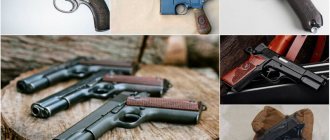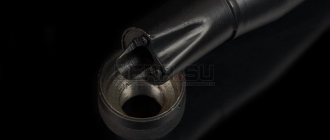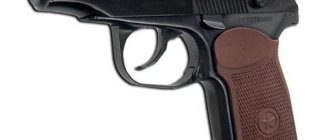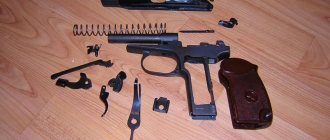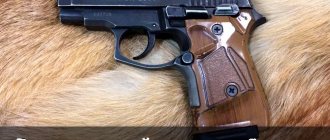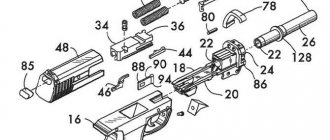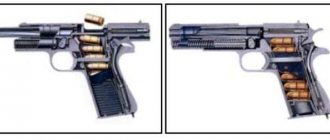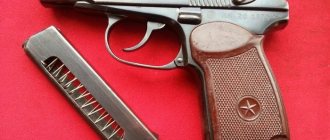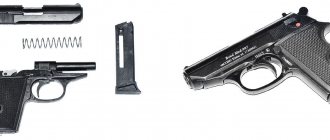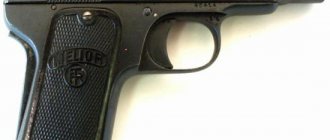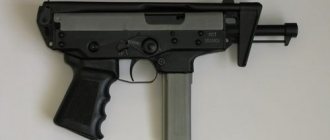Pistols Model-1, Welrod Mk. II, Welrod Mk. I
Welrod (Welrod) is a silent, manually reloading repeating pistol, developed in 1942 in Great Britain for arming special services, reconnaissance and sabotage, airborne units and resistance groups in the occupied territory of Western Europe during the Second World War.
the name “Welrod” from the first three letters of the name of the town where the experimental design bureau (Station IX) was located ( WEL wyn- ROD ), and “ ROD ” was supposed to symbolize the appearance of the weapon (from the English “ Rod ” - rod, kernel). According to another version, the second part of the name “Rod” could have been borrowed from American slang for “gun.”
History of creation and production
The defeat of the English expeditionary force and allied forces by fascist Germany in 1940 at Dunkirk, which entailed the evacuation of the combined forces to the British Isles, forced Great Britain to move in the fight against Germany by conducting covert special operations on the continent, relying on both the expanding Resistance movement in Europe , and for the deployment of individual groups of agents and sabotage units.
The effective implementation of special combat missions required the creation of special types of weapons, radio equipment, equipment, explosives and other means of combat. To this end, in 1941, in the town of Welwyn (Hertfordshire), 30 miles north of London, the British Special Operations Executive (SOE), organized a multidisciplinary development ISRB (Inter Services Research Bureau), later named Station IX, under the leadership of DM Nevitt, an explosives specialist.
Like any weapon, the Welrod pistol was preceded by the development of a silent pistol called the Model-1 chambered for the 7.65 mm Browning cartridge (.32 ACP) and with a longitudinally sliding bolt similar to the German Mauser 98K carbine. It was equipped with an integral dual-purpose magazine made of thin metal: on the one hand, it served as a pistol grip used for shooting and reloading, on the other, it was a double-row magazine for 5 rounds, loaded like the German Mauser C96 pistol.
Model-1
In November 1942, by order of the Chief of Combined Operations (CCO), after extensive testing, a batch of 500 pieces was manufactured.
Shorter compared to the subsequent Mk model. The second magazine handle, unfortunately, made it inconvenient to operate the trigger mechanism. In addition, the need to equip the magazine from above, bolt reloading and a sliding bolt led to the development and production in March 1943 of a new model known as the Welrod Mk. II".
In 1942, an employee of this bureau, Major Hugh Reeves, developed a single-shot, with an integrated silencer, firing device for the 7.65 mm Browning pistol cartridge (.32 ACP), which was supposed to be carried on a cord in the sleeve and used from this position. However, the first tests of the sample and reviews from the military showed that the device must be supplemented with a magazine with a familiar pistol grip.
Therefore, in 1943, the 7.65 mm silent pistol “Welrod Mk. II", serial production of which began at the end of 1943 at the plant of the English company Birmingham Smal Arms Co, Ltd (BSA). In total, about 2800 pieces of this model were produced.
Welrod Mk. II on the left and Welrod Mk. IIA right
Model "Welrod Mk. IIA" was different from the previous model "Welrod Mk. II" with a more technologically advanced design. In addition to minor design differences, the shape and guide of the bolt were changed.
Some design features:
- The magazine was a modified magazine of one of the most popular compact semi-automatic pistols of the time, the Colt Model 1903 Pocket Hammerless, using the 7.65 mm Browning (.32ACP) cartridge.
- The magazine has become detachable, simultaneously serving as a pistol grip.
- With an actual magazine capacity of 8 rounds, the manual recommended loading them with a maximum of 5 rounds for reliable supply.
- Despite the fact that the pistol is not self-loading, reloading was done relatively quickly.
- The barrel bore was unlocked by turning counterclockwise 90° and pulling the bolt washer back; locking was done in the reverse order.
- Extraction of the spent cartridge case was carried out vertically according to the principle of extraction of the cartridge case of a Luger pistol (Luger P.08).
In the USA, a copy of the Welrod pistol was produced with minor changes called “.32 Hand Firing Mechanism, Mod. Mk.1" (7.65 mm hand-held firing device, mod. Mk.1). A significant part of the released samples were in service with the US Navy.
American Welrod Mk. II
In the period from October 1, 1943 to October 10, 1944, intensive tests were carried out on 7.65 mm and 9 mm models of the Welrod pistol.
At the end of 1944, a more powerful 9-mm modification of the Welrod Mk pistol was launched into production. I" chambered for the Parabellum pistol cartridge. The total number of manufactured series was approximately 14,000 pieces.
Welrod Mk. I
Design and operating principle
The Welrod pistol is a repeating weapon with manual reloading. The barrel is locked by a rotary bolt with two lugs. The movement of the bolt during reloading is carried out manually, using a notched sleeve located in the rear of the cylindrical receiver of the weapon. The front of the pistol's receiver also houses the integrated silencer. It contains metal partitions and rubber separators between them. Each time a bullet is fired, it passes through these separators, punching through them, as a result of which a set of separators could withstand only 15 shots, after which they had to be replaced due to a sharp decrease in the effectiveness of the suppressor. This did not present any difficulties, since the Welrod pistol was not designed for intense fire, and in calm conditions the separator set could be replaced after disassembling the silencer. The trigger mechanism is of the striker type, single action. There is an automatic safety on the back of the handle, which makes a shot impossible until the shooter wraps his hand around the pistol grip. The sights are not adjustable and have luminous inserts.
Silencer device Welrod Mk. II
The difference between the Welrod Mk. I from Mk. II, in addition to the caliber, is the presence of a trigger guard and a non-automatic safety in addition to the automatic one on the handle, as well as a removable front part of the muffler.
Sleeve Gun
A more compact version of the Welrod Mk pistol was also developed. II without a pistol grip under the name “Sleeve Gun” - “sleeve gun”. This weapon, chambered for the 7.65mm Browning cartridge, was created by the 9th Department of the USO (Station IX, SOE) at the end of 1943 and was distinguished by the fact that the pistol body consisted only of a receiver with a trigger. The Sleeve Gun chambered for the 7.65 mm Browning cartridge was intended to be carried concealed on a rubber cord in the sleeve at forearm level.
Only war
Continuing the conversation about the silent weapon system of the British army, one cannot fail to mention the pistol of this family - the Welrod.
The pistol was designed specifically for special operations, where stealth was paramount. The need to “adjust” the pistol to dimensions acceptable for transportation (including concealed) with high quality sound absorption forced us to start working with the relatively weak 7.65 Bruning cartridge. However, the weakness of the cartridge did not in the least prevent its use in both civilian and military weapons of the first half of the last century. A small charge and, accordingly, a small volume of gas when fired allowed the use of a compact silencer. The British put the secrecy of the application at the forefront - therefore they abandoned automation and the shutter click when reloading. The pistol, like a repeating rifle, was reloaded by the shooter after each shot. At the same time, the rigid locking of the bolt eliminated the formation of noise during operation of the automation and the partial removal of gases through the barrel breech. And even with a single shot, the pistol, like the revolver, was not loaded with cartridges.
The second feature of the pistol was its deliberate simplicity: the war did not allow production to be loaded with complex weapons that required a large number of engine hours and the work of qualified milling machines. Of course, ergonomics suffered. There was nothing really, just functionality. However, the first version of the pistol, developed in 1942, was too inconvenient, so a year later the more user-friendly Welrod MkII appeared. It would seem that everything could be simpler: the pistol was a set of tubes and molded parts, and the role of the handle was performed by a slightly modified Colt magazine with a special sleeve that made it easier to hold the weapon. The magazine capacity was 8 rounds, but the design features made the feeding of the first three rounds unreliable (the force of the compressed spring was not very convenient to win with manual feeding...), so it was recommended to equip the magazine with only five rounds. The trigger usually vaguely resembled the trigger of a regular pistol, representing a key attached directly to the trigger rod. Without a magazine, the pistol looked like a “tube”, and when preloaded, it allowed you to shoot even without a magazine.
This gave the British the idea of a “guillotine gun,” which could fire a single shot, but, unlike the assembled Velrod, could be concealed. Of course, making the success of the operation dependent on a bullet from a Browning cartridge was risky, but it was a quiet shot...
The non-self-loading “Velrod” was not a big drawback - the shutter operated very quickly, and the specific use of the gun did not provide for active fire extinguishing. If the enemy managed to raise the alarm and open fire, then the secrecy of the operation is beyond doubt. The virtually silent cannon made it possible to "shoot" the sentries, providing a covert mission or at least getting close to the enemy to the point where his advantage in firepower was minimized. However, the weakness of the Browning 7.65 cartridge was still a significant drawback, and a year later, in 1944, a new version of the Velrod, the Mk1, was released. The new pistol was a little more technologically advanced and already used the 9 Parabellum cartridge.
The simplicity of Welrod is simply incredible: talking about it is already a kind of provocation, because in the presence of welders and a lathe, appearing in full view of an average-skilled blacksmith is quite possible.
As you can see, the disassembled pistol looks more like a handmade product using available equipment than a factory weapon. However, it was simple, inexpensive and worked well. In addition, the pistol had an automatic safety!
At the same time, the sound damping efficiency will be quite high if the correct design of the muffler is observed. The muffler, by the way, is far from technologically advanced, but it is technologically advanced enough.
A set of deflectors and thrust washers, three rubber diaphragms, pierced by a bullet when fired. Yes, it's quite simple, but diaphragms have extremely limited survivability and negatively affect the bullet's accuracy even at very short distances. At the same time, such deflectors perfectly cut off gases, both directing the projectile and following it. Suffice it to recall the conscientious “BRAMIT”, who used only them (although the volume of the gun barrel worked no worse than a separate expansion chamber). In general, with such a specific use of the pistol, the shortcomings of the “membrane” system did not spoil it much, but the ease of maintenance of the silencer played into the hands of the user. Apparently, he also reminded the designer with a “kind and quiet word”: the set of parts turned out to be impressive, but the separators assembled into a block have not yet gone into production... Considering the history with the same “BRAMIT_s” and “winter” membranes made of rubber on land - I’m licking in general, the British had no problems with the destruction of washers in the cold. And in conditions of extremely low temperatures, Velrods, as a rule, did not fire...
With all the described quirks and deliberate simplicity, the Welrods fought in the hands of British, American and Australian special forces, and the first fought with these weapons... even in the first campaign in Iraq, not to mention the Falklands! It is not surprising that with the advent of more modern weapons and changes in tactics, old Welrod was forced to retire. It’s surprising that the famous weapons manufacturer Brugger & Thomet decided on a kind of “remake” of the legendary Velrod. The new product received the simple name “VP-9”, designed to use the conventional Parabellum cartridge. The use of modern materials made it possible to make the gun almost half the size of its predecessor, and most importantly - much more comfortable than the old one... At the same time, almost all design solutions of the prototype were transferred to the new product - even the design of the trigger, not to mention the charging circuit.
A simple “clamp” with a Picatinny rail made it possible to use a variety of “accessories” on the new product, such as a flashlight or laser laser, which comes in handy here. However, in our time, a flashlight and laser center in the unit have long ceased to surprise anyone and have removed the problem of choice for the shooter. A removable suppressor allows you to carry the pistol to the point of use, perhaps two in your shorts pocket. I think the question is “for whom was this miracle performed?” It arose not only for me... This is probably why the manufacturer honestly assured us that this pistol is VETERINARY, that is, it is intended for the slaughter of livestock by people and has a silencer so as not to frighten the neighbors in the barn. Well, what about... bulls are different too
Silent pistol Welrod Mk.I / Mk.II
Silent pistol Welrod Mk.I
Silent pistol Welrod Mk.II
The Welrod silent pistol with magazine feed and manual reloading was designed in Great Britain in 1942, with the aim of providing secret services, reconnaissance and sabotage groups, airborne units and resistance movement units in the occupied territories of Western Europe with weapons for concealed use. This unusual pistol, despite its “not serious” appearance and caliber, was quite successfully and actively used by the special forces units of the British SAS (Special Air Service) and SOE (Special Operations Executive), as well as the American OSS (Office of Strategic Services) and the Australian SRD (Office of Intelligence Services).
After the defeat of the Allied forces and the British Expeditionary Force at Dunkirk in 1940, followed by the evacuation of the combined forces to the British Isles, Great Britain moved to a new phase of military operations against Nazi Germany. Preparations began for conducting special operations in territories occupied by German troops. It was planned both to supply weapons, ammunition and equipment to the Resistance movements throughout Europe, and to send agents and sabotage units into the occupied countries. To carry out most combat missions in territory occupied by the enemy, a special weapon was required to ensure the invisibility of its use.
In 1941, to develop such weapons in the town of Welwyn, Hertfordshire, 30 miles north of London, the British Special Operations Executive (SOE) created a multidisciplinary development bureau, the Inter Services Research Bureau. (ISRB). This bureau later received the name 9th Department (Station IX), under the leadership of D.M. Nevitt (DM Nevitt), an explosives specialist.
Among the tasks in designing the so-called “silent” weapons was the development of a pistol. The designers decided not to use a conventional self-loading pistol with a silencer attached to the muzzle of the barrel due to the noise created by the bolt when fired. The silent pistol began to be created from scratch. The cartridge used was 7.65mm Browning (.32 ACP). Manual reloading was chosen as the operating principle. The weapon received a longitudinally sliding rotary bolt with two lugs, similar to the German Mauser 98K carbine. The pistol was fed with cartridges from an integral box magazine. The store itself also served as a handle for holding the weapon. In order to give the hold at least a semblance of convenience, a rubber casing was put on the magazine.
In accordance with the order of the Chief of Combined Operations, in November 1942, after extensive testing, a batch of 500 copies of such silent pistols was manufactured. At the end of 1943, the Birmingham Smal Arms Co, Ltd (BSA) plant put this pistol into mass production under the name Welrod Mk.II. The total production volume of this model was 2800 pieces. There was also an improved version - Welrod Mk.IIA, characterized by greater manufacturability, as well as a different guide and bolt shape.
For the Welrod Mk.II pistol, they decided to use the detachable box-shaped single-stack magazine of the very popular Colt Model 1903 Pocket Hammerless compact pistol in the USA for the same 7.65 mm Browning (.32ACP). A notched bushing was used to load the weapon. Using this bushing, the barrel bore was unlocked by turning the bolt counterclockwise by 90°. Next, the shooter pulled the sleeve back and the bolt moved to the rearmost position, removing the spent cartridge case from the chamber and throwing it out through the window at the top of the receiver. The next cartridge from the magazine was sent into the chamber by closing the bolt and turning it clockwise. Despite the fact that reloading was done manually, it took quite a bit of time.
Diagram of the Welrod Mk.I silent pistol
Diagram of the Welrod Mk.II silent pistol
The front of the Welrod Mk.II receiver is also the housing for the integrated suppressor. It contains metal partitions and rubber separators between them. Each time a bullet is fired, it passes through these separators, punching through them, as a result of which a set of separators could withstand only 15 shots, after which they had to be replaced due to a sharp decrease in the effectiveness of the suppressor. This did not present any difficulties, since the Welrod pistol was not intended for long shootouts. After eliminating the target, the set of separators could be easily replaced when cleaning the weapon. The trigger mechanism is striker type, single action. Behind the magazine receiver there is a hand-operated automatic safety, which makes a shot impossible until the shooter wraps his hand around the pistol grip. The sights are not adjustable and have luminous inserts.
Experience in combat use by intelligence agents, special forces and resistance units has shown the need for a silent pistol chambered for a more effective cartridge. As a result, at the end of 1944, the Welrod Mk.I pistol chambered for 9x19 entered production. The Welrod Mk.I silent pistol differed from the Mk.II by the presence of a non-automatic safety and trigger guard, as well as a removable front section of the silencer. The total number of Mk.Is produced was about 14,000. A copy of the Welrod pistol with minor modifications was produced in the USA by the Southwest Pump Company under the name ".32 Hand Firing Mechanism, Mod. Mk.1" (7.65 mm hand-held firing device, mod. Mk.1). Most of these weapons went to the US Navy.
A version of the Welrod Mk.II pistol without a pistol grip was also developed under the name “Sleeve Gun”. This weapon, chambered for the 7.65mm Browning cartridge, was created by the 9th Department of the USO (Station IX, SOE) at the end of 1943 and was distinguished by the fact that the pistol body consisted only of a receiver with a trigger. The Sleeve Gun was intended to be carried concealed on a rubber cord in a sleeve at forearm level. After eliminating the target with a point-blank shot, the weapon was put back into the sleeve. Since there was no handle, there was no magazine, but this weapon was designed for only one silent fatal shot. If the operation to eliminate the target was successful, the weapon could be unloaded, cleaned, loaded and ready for the next use. The Sleeve Gun was tested by the US Office of Strategic Services (OSS) in mid-February 1944 and early January 1945, but was never adopted. There is no information about its combat use.
Use
In 1943, there was a plan to drop them into German-occupied territories for the massacre of SS and Gestapo officers and soldiers within a month by resistance units. This plan may have been delayed or canceled after Operation Anthropoid, the assassination of Reinhard Heydrich by Czech resistance forces. After his assassination, approximately 13,000 civilians were arrested and interrogated, 5,000 civilians were killed in reprisal killings by the Germans, and the villages of Lidice and Ležaki were destroyed.
The Welrod was used in Denmark during World War II, as well as in use in several other countries, and was reportedly used during the 1982 Falklands War, throughout the Northern Ireland Troubles, and during Operation Desert Storm by British Special Forces . Welrod pistols were also found in weapons caches during Operation Gladio.
